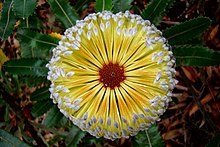
Back بنكسية Arabic بانكسيا (جنس من النباتات) ARZ Banksiya Azerbaijani Banksia Byelorussian বাঁকসিয়া Bengali/Bangla Banksia Catalan Banksia CEB Banksie Czech Banksien German Banksia Esperanto
This article includes a list of general references, but it lacks sufficient corresponding inline citations. (June 2023) |
| Banksia Temporal range:
| |
|---|---|

| |
| Banksia serrata | |
| Scientific classification | |
| Kingdom: | Plantae |
| Clade: | Tracheophytes |
| Clade: | Angiosperms |
| Clade: | Eudicots |
| Order: | Proteales |
| Family: | Proteaceae |
| Subfamily: | Grevilleoideae |
| Tribe: | Banksieae |
| Genus: | Banksia L.f. |
| Type species | |
| Banksia serrata | |
| Diversity | |
| About 170 species | |

| |
| Distribution of Banksia within Australia | |
| Synonyms[1] | |
Banksia is a genus of around 170 species of flowering plants in the family Proteaceae.[1] These Australian wildflowers and popular garden plants are easily recognised by their characteristic flower spikes, and woody fruiting "cones" and heads.[2]: 1 Banksias range in size from prostrate woody shrubs to trees up to 30 metres (100 ft) tall. They are found in a wide variety of landscapes: sclerophyll forest, (occasionally) rainforest, shrubland, and some more arid landscapes, though not in Australia's deserts.
Heavy producers of nectar, banksias are a vital part of the food chain in the Australian bush. They are an important food source for nectarivorous animals, including birds, bats, rats, possums, stingless bees and a host of invertebrates. Further, they are of economic importance to Australia's nursery and cut flower industries. However, these plants are threatened by a number of processes including land clearing, frequent burning and disease, and a number of species are rare and endangered.
- ^ a b "Banksia L.f." Plants of the World Online. Royal Botanical Gardens, Kew. 2023. Retrieved 23 June 2023.
- ^ Banksias (Proteaceae) (PDF). Australian Plants Society NSW. 2021.